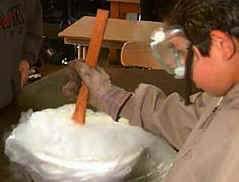
Although the examples in our History section are few, humans in many cultures have been observing comets for a very long time. Oriental astronomers recorded comet sightings in ancient China, Arabic astronomers, Greeks, and Mayans were all fascinated by them. Your students may be interested to know that a Japanese boy named Matasaburou observed a comet in the 17th century, which he named the "tiger-tailed star."
Comets in Science
The development of western scientific thinking coincides rather closely with history and knowledge of comets. First there was wonder, followed by fear and apprehension. Some leaders no doubt used the appearance of a comet as a propaganda opportunity for their own ends, but unlike planetary movements, or eclipses, no one learned to predict when a comet would appear until the late 17th century. They were attributed to the whim of God or gods, and comets were often depicted as supernatural or god-sent omens of tragedies or miracles (1300, 1402).
